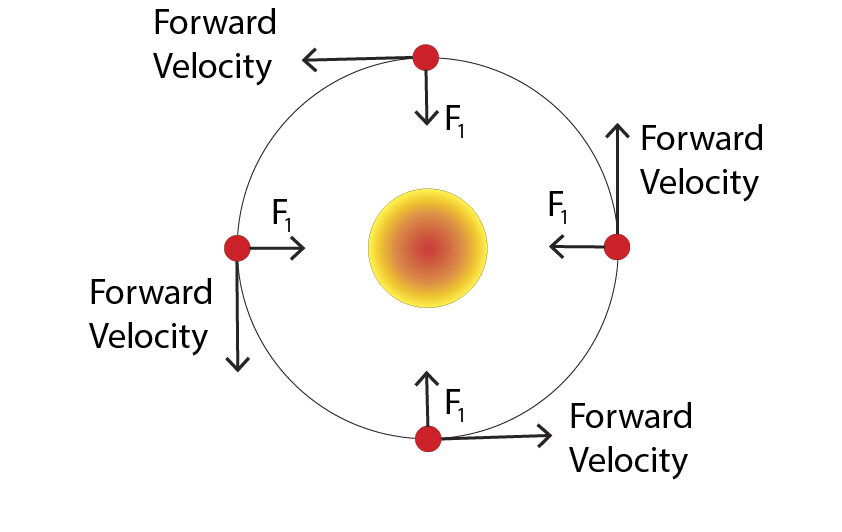AQA GCSE Orbits (Physics)
Orbits
An orbit is a path that one object will have around another.
A planet orbits around a star.
Natural satellites such as moons orbit around a planet.
Artificial satellites, which are man made also orbit around planets.
These orbits are typically elliptical (oval). However, in this part we are going to assume they are circular as it simplifies the explanation for how that orbital path is maintained.
Gravity provides the force that allows planets and satellites (both natural and artificial) to maintain their circular orbits.
Mercury orbiting the Sun
Mercury orbits the Sun in an anticlockwise orbit.

The Sun will exert a gravitational force on Mercury, this force arrow has been labelled as F1.
At the same time, Mercury will have a forward velocity, this has been labelled with a velocity arrow.
This force arrow F1, acts towards the centre of the circle, so it is a centripetal force. This centripetal force is the only force acting on this planet, so it is also a resultant force.
This resultant force will cause the planet to accelerate towards the centre of the Sun, due to Newton’s 2nd law F = ma.
However, remember that the planet had a forward velocity. The force will cause the directional component of the velocity to change. As a result it will form a curved path around the Sun.

However, remember that the planet had a forward velocity. The force will cause the directional component of the velocity to change. As a result it will form a curved path around the Sun.
Also, remember that the velocity is changing here because the direction is constantly changing on the circular orbit.
However, if you were referring to speed, the speed could be constant because speed does not depend on direction.

Orbital velocity
In order to maintain the circular orbit, the object needs to have just the right velocity
If Mercury moves too slowly, it could crash into the Sun
If Mercury moves at just the right velocity it will maintain its orbit
If Mercury moves at too high a velocity it will fly off into space.

Orbital Velocity and altitude
The higher the altitude of the satellite from the surface of the Earth, the weaker the force of gravity that the satellite experiences from the Earth.
As a result in order to maintain its orbit, its orbital velocity will be lower
Higher the altitude of satellite, weaker force of gravity experienced by satellite, so slower orbital velocity.
Lower the altitude of satellite, stronger force of gravity experienced by satellite, so higher orbital velocity.

Practice Questions
1.State the name of a force that keeps one object in orbit around another.
2. Explain why the speed of the Earth orbiting the Sun is constant, but its velocity is constantly changing
3. If a planet has two moons, one in low orbit and another in a higher orbit. Explain why the lower orbit moon travels faster
Absorption and Emission of EM Radiation
JJ Thomson and Plum pudding model
Ernest Rutherford and the Nuclear Model
Niels Bohr changing the Nuclear Model
Discovering the Proton and Neutron
Measuring radiation from radioactivity
Radiation types and properties
Random nature of radioactive decay
Radioactive contamination or irradiation
Hazards of contamination and irradiation
Studies on the effects of radiation on humans
Different half lives of radioactive isotopes
Nuclear Fission Chain Reaction
Writing nuclear fission equations
Drawing ray diagrams for a concave lens
Drawing Ray Diagram to produce a virtual image for a convex lens
Drawing ray diagram to produce a real image for a convex lens.
Specular and Diffuse Reflection
Seeing Coloured Objects Part 2
Viewing objects through coloured filters
Transparent, Translucent and Opaque